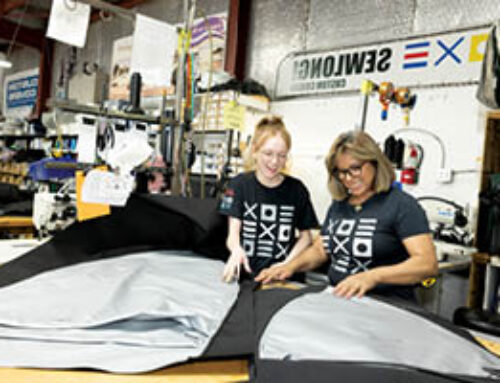Cruising on the web

Desktop computer and pink wall – home office concept
Everyone has a website these days. Right?
You don’t?
Cheer up. In a way, even if you don’t have a website, you’re in the same boat with a lot firms that do. Many people, hosting a web presence or not, are still trying to figure out how to design and maintain a site that actually helps their business, and at a reasonable cost. And an added challenge—and opportunity—is the proliferation of social media, such as Facebook and LinkedIn, which can draw prospects to your site and help build sales. It’s a new, strange road.
Take the case of Carol Kleinert. She has a website for her roll-curtain and boat-cover business. Her son worked out much of the copy for the site, and then emailed it to the web-design firm she had selected. So how did it go?
“Be wary,” sighs Kleinert, president of Traverse Bay Canvas in Harbor Springs, Mich. She has, shall we say, mixed feelings about web-design firms. “I think,” she says, “they’re not all they’re cracked up to be.”
For the time being, Kleinert isn’t pleased with her online presence. Even though her own firm created the copy for the site, designing it cost her $3,000. Now she’s shopping around for a redesign—and a way to fit it into her budget.
How quickly do you pull the plug on a website you don’t like? Kleinert’s disappointment notwithstanding, the site she dislikes has, she allows, “given me a lot of business.”
Arguably, then, being out there for customers and prospects may be a good thing—even if you don’t like your site.
Indeed, you want a site you do like—but how much should you have to pay? You might have a web-design whiz in the family or on the payroll who could build the site at a possibly lower cost. More likely, however, to put up a good site—or Facebook page—you’ll need to hire a professional.
Jerry Grimaud’s firm does waterfront work. The president of Lawrence Fabric and Metal Structures in St. Louis thinks you might expect to pay up to $1,000 for a design professional to create a web presence. And, he adds, don’t forget the probable monthly maintenance fee of $150 or so. Yet, who knows? You might find a gem of a design firm and cheap maintenance. “It’s a continuing education,” Grimaud adds.
First, prospects can look at online photos of work in which the firms take pride. And if prospects like what they see, they can be in contact via the web. Thanks in part to her site, Kleinert sells roll curtains all around the country. She even knows what it costs to ship to Hawaii.
Her clear-vinyl roll curtains block wind, make porches more comfortable in cool seasons, and cut heating bills and maintenance costs. In fact, roll curtains make up 60 percent of her business—and they work for boaters’ waterfront properties as well as inland customers. (Traverse Bay Canvas does boat work, too, getting requests via the web for boat curtains.)
So, the web can boost sales. But before you budget for a site, ask yourself—where do you start? What is your website supposed to do?
Somewhere, a prospective customer is ready to buy what you’re selling. But that prospect may not be thinking specifically of your company—may not know what you can do. May not even know you exist.
A prospect might open a smart phone (or laptop or desktop computer), check Google or Facebook or LinkedIn, and punch in certain key words—“boat covers,” for example.
Wham! There you are in front of them onscreen, with some nice photos of your products installed. Instant sale! Right? Ideally, but it’s not that simple. It requires some preparation on your part.
For example, on your website, always have photos of your recent work. And those photos have to be available so your potential client doesn’t have to wait long for them to load. If that takes too long, especially for someone checking a handheld device just when the phone rings, the prospect may say, “Forget it,” and move on. So keep it lean—maybe a click-on to view the individual photo.
Exhibiting your best, most recent work is important. A website is “never done,” says Grimaud. “It’s a work in progress. If you think you’re done with your website, then you’re going to be done. You’ve got to keep upgrading.”
And remember the people who will see your posts. Yoon Cannon, based in Doyleston, Pa., is a consultant, author, and speaker. She suggests Facebook is more of a down-time, personal network. LinkedIn is more businesslike. “Facebook,” Cannon says, “is kind of going to your neighborhood party.”
So put aside the hard sell. Coupons? No, says Cannon. “People do not like to be advertised to on social media. The first objective is to build a relationship.” Moreover, it’s possible that prospects and existing customers might not spend a lot of time on social media. And if they don’t, Cannon suggests, you might consider delicately networking among the professionals who work with your customers and prospects. Are boaters affluent enough to spend a lot of time with lawyers and accountants? You might gently probe those professional networks.
Do so-called social media—Facebook, LinkedIn, Twitter, and others—drive traffic to your website? Does a social-media presence pay off?
You might never know with certainty, but you can make a guess. “Sure, it makes the phone ring,” says Karen O’Rourke, Lawrence Fabric and Metal Structures’ marketing director in St. Louis. “But as far as putting a dollar figure on it, I don’t think we can.”
Her boss Grimaud’s advice is that you should never try to solicit a sale through social media. “Not only will the attempt fail,” he writes in an email, “but it can backfire.”
Instead of a hard sell, share your expertise, consultant Cannon advises. For example, your posts might be about how to care for your fabrics, what fabric works best under various conditions, and the like.
Ideally, if prospects and customers are sufficiently interested, they will sign up for a regular emailed newsletter. Cannon calls this “drip marketing.” It’s a key step in the process of what she calls the “know-like-trust factor.”
Once you have a significant number of “likes” on your social-media site, it might be time to invite people to the open house you’ve been planning. Of course, you should announce it in old-fashioned local media as well.
Social media are “a tool in your toolbox,” says Charlene Clark, a social-media user who is co-owner and vice president of
Signature CanvasMakers in Hampton, Va. “I don’t want people to think that if you have a Facebook page you don’t have to do any other marketing.”
Yet in contrast to traditional print media, when you post your open house—or whatever event—on social media, you can readily measure the number of connections, number of comments, number of “likes,” number of times people relay the information and more.
Going viral? That means people on your network contact others on their networks. “They did a great job for me,” they might say. That can mean a lot of business—or it can mean disaster. In the words of the Harvard Business Review, “One angry tweet can torpedo a brand.” If one grumpy customer is in touch with your whole social-media network and says, “They did a lousy job”—ouch! If you’re active in social media, that possibility means you must pay more attention than ever to doing superb work.
In any case, your business comes first. Experiment a bit to see what works. Read magazines, including this one, and go to presentations by people at IFAI and MFA shows who know websites and social media.
And remember: Everybody’s website is a work in progress. We’re all making it up as we go.
Marc Hequet is a freelance writer from St. Paul, Minn.
 TEXTILES.ORG
TEXTILES.ORG 






